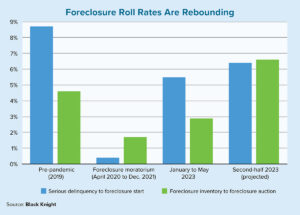As of this past July, the U.S. was beginning to see the first bankruptcies in the wake of the COVID-19 pandemic. Dorsey & Whitney’s H. Joseph Acosta, a veteran bankruptcy lawyer, spoke with Scotsman Guide about what typically happens to commercial real estate assets during these proceedings and what the impact on the commercial-property market could be over the next year.
Do you expect a wave of companies to file for bankruptcy?
I do not expect a wave immediately, due to the government levitating the economy during the first half of 2020. Looking at history to the 2008 mortgage meltdown, it wasn’t until the following year when you saw the wave of filings. I expect that it will be something similar this time around.
But companies are hurting. Companies like Bed, Bath & Beyond recently announced that [fiscal first-quarter 2020] revenues dropped 50% [year over year], so they have to close 200 stores in the next couple of years. Some predict that at least 25% of malls are at risk. Then, the Independent Restaurant Coalition recently predicted that 85% of [nonchain] restaurants will close by the end of 2020 due to the pandemic. A lot of those dynamics are percolating, but the real estate market hasn’t really seen a significant visible impact yet.
What typically happens to a company’s property in a bankruptcy?
There are all different types of situations. The property can be sold or there’s a reorganization, where the encumbered property is reorganized through a new loan or a recapitalization. The debt owners become part equity owners. It’s just whatever solution the owners can find for that property.
You have income-producing properties and non-income-producing properties. The latter is more likely to need more funding to pay for the restructuring costs. You also have property owners that own multiple properties, and that’s a different dynamic in and of itself. Sometimes they’ll sell some less-desirable properties to raise revenue.
The Chapter 11 bankruptcy process is intended to prevent foreclosure, prevent the properties from being taken away and give the owner some time to develop a plan that settles with all creditors. In contrast, Chapter 7 entails handing over ownership of the property to a Chapter 7 trustee to liquidate and then distribute any proceeds to creditors. This is a viable option if the owners or management do not see a realistic way to reorganize. Generally speaking, owners do not favor this approach because it means losing the property.
For property owners who have just completely exhausted their cash prior to filing (for bankruptcy), the survival rate is not high.
How long can a company survive?
For property owners who have just completely exhausted their cash prior to filing, the survival rate is not high. They have to be able to demonstrate to the bankruptcy court pretty quickly that they actually have a plan and enough funding to reorganize, and do something feasible with the obligations that encumber the property.
Again, it has not been a big problem so far this year because real estate has remained relatively resilient. As defaults keep mounting amongst the tenant ranks, it might become more of a problem in the second half of 2020 and in 2021, especially if property owners aren’t paid by a sufficient number of tenants, such as mall owners who have mounting debts of their own and a lot of pressure by their lenders.
What industries are in the weakest positions?
The travel industry is very vulnerable, claiming victims like the $25 billion Hertz Corp., Advantage Rent A Car and a handful of foreign airlines. The retail industry is also vulnerable due to the lack of foot traffic. The energy industry is another victim, because businesses are closed and there’s no energy consumption, so prices are down with low demand. ●






